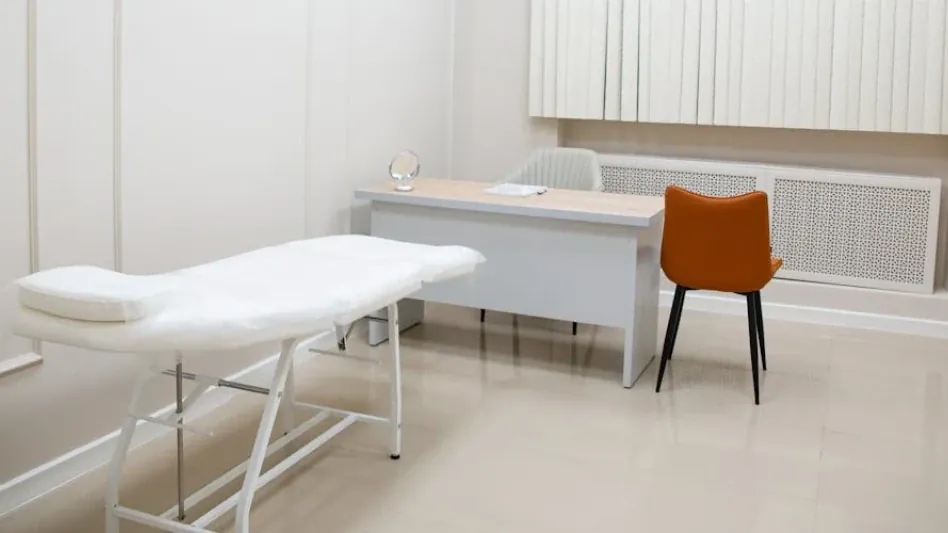In clinical trials, the environment plays a critical role in shaping the patient experience and the overall success of the trial. Traditional clinical spaces, often characterized by their cold and sterile design, have been widely criticized for their emphasis on process efficiency at the expense of patient comfort. These impersonal settings can contribute to higher rates of patient drop-off and enrollment difficulties, ultimately hindering the success of clinical trials. To address these issues, a new approach focuses on redesigning clinical trial spaces to create warm, welcoming, and homelike environments that prioritize patient comfort and foster a sense of hope.
The Problem with Traditional Clinical Trial Spaces
Traditional clinical trial spaces are designed with a primary focus on provider convenience and process efficiency. These spaces typically feature stark, clinical aesthetics, including white walls, minimalistic furniture, and a general lack of personalization. While this design may streamline medical procedures and operations, it tends to create an intimidating and unwelcoming atmosphere for patients. The cold, sterile environment can exacerbate feelings of anxiety and discomfort, which are already prevalent among patients undergoing clinical trials.
The impersonal nature of these traditional spaces often leads to negative psychological effects on patients. When patients feel uneasy or unwelcome, their willingness to participate in and commit to clinical trials diminishes. This, in turn, contributes to higher drop-off rates and significant challenges in patient enrollment. The high failure rates of clinical trials due to these issues underscore the urgent need for a shift in how these spaces are designed. By placing a greater emphasis on creating environments that feel more personalized and familiar, it becomes possible to improve patient experience, enhance emotional well-being, and increase the likelihood of trial success.
The Science of Hope
The concept of the “science of hope” is rooted in psychological research that recognizes hope as a critical factor in resilience and positive health outcomes. Hope is defined as a goal-oriented mindset that enables individuals to envision a path toward a desired future, even in the face of challenges. This psychological state has been shown to significantly impact a person’s outlook and their ability to cope with stress and adversity. By integrating elements that promote hope into the design of clinical spaces, it is possible to create environments where patients can experience a tangible sense of optimism and possibility.
Hope is not a mere fleeting emotion but a profound psychological state that can deeply influence patient behavior and engagement. When clinical trial spaces are designed to foster hope, patients are more likely to feel positive, motivated, and actively involved in their treatment. This sense of hope can enhance psychological resilience, improve mental health outcomes, and increase patient participation in clinical trials. Elements such as natural light, calming colors, and inspirational artwork can contribute to cultivating an atmosphere of hope, making patients feel more supported and empowered throughout their treatment journey.
Drawing Inspiration from Cancer Treatment Centers
Cancer treatment centers have long been recognized for their innovative and patient-centered design approaches that prioritize comfort and engagement. These centers serve as exemplary models for redesigning clinical trial spaces to better meet patient needs. Features typical of cancer treatment centers include comfortable seating, soothing views of nature, and engaging activities to occupy patients during their visits. By adopting similar design philosophies, clinical trial spaces can transform into more inviting and supportive environments that ease patient anxiety and promote well-being.
Cancer treatment centers frequently incorporate elements that create a therapeutic and homelike atmosphere. Comfortable chairs are provided to patients, allowing them to relax during long treatment sessions. Large windows offering views of nature or serene landscapes contribute to a calming ambiance that can significantly reduce stress levels. Additionally, activities such as reading materials, puzzles, and crafts are made readily available to keep patients engaged and distracted in a positive manner. By embracing these design principles, clinical trial spaces can foster a sense of tranquility and normalcy, helping patients feel more at ease and cared for.
Creating Central Living Areas
A key aspect of the redesign approach is the incorporation of central living areas that resemble a home’s living room and kitchen. These areas are designed to foster a sense of normalcy and relaxation, providing patients with a space that feels familiar and comforting. The central living area serves as a communal hub where patients can gather, socialize, and engage in activities that make their time at the facility more pleasant and less stressful. Including features such as an open kitchen, personalized food and beverage options, streaming services, and game passes can significantly enhance the overall patient experience.
The central living area is intended to break the monotony of traditional clinical environments and create a welcoming space where patients can feel more at home. The open kitchen allows patients to enjoy customized meals and snacks, catering to their dietary preferences and needs. Access to streaming services and entertainment options such as video games provides much-needed distractions during long hours at the facility, helping to alleviate boredom and fatigue. By creating a central living area that mimics the comfort and familiarity of home, clinical trial spaces can offer a more positive and supportive experience for patients.
Age-Appropriate Zones and Quiet Rooms
To cater to the diverse needs of patients, it is essential to include dedicated areas designed for different age groups and sensory requirements. The redesign approach acknowledges that patients of various age groups have distinct preferences and needs, and it is important to create spaces that accommodate these differences. Age-appropriate zones are equipped with activities and features tailored to the interests and comfort levels of different age demographics. This ensures that all patients, regardless of age, can find spaces that support their well-being and provide a sense of belonging.
Special attention is given to neurodivergent children, who may require environments that minimize sensory overload and promote calmness. Quiet rooms are designed with soft lighting, soundproofing, and soothing decor to create a tranquil space where neurodivergent patients can decompress and manage sensory sensitivities. These quiet rooms serve as safe havens for patients who need a break from the hustle and bustle of the clinical environment. By addressing the unique needs of neurodivergent individuals and offering diverse, inclusive spaces, clinical trial facilities can foster a more supportive and patient-centered atmosphere.
Overcoming Regulatory Barriers
One of the significant challenges in redesigning clinical trial spaces is navigating regulatory standards that govern healthcare environments. Initially, there may be perceived barriers related to compliance, leading to concerns about the feasibility of implementing creative and patient-friendly designs. However, there is often more flexibility within regulatory frameworks than expected, allowing for innovative and compliant design solutions. By thoroughly understanding and adhering to regulatory requirements, it is possible to integrate comfortable and engaging elements into clinical spaces without compromising safety and standards.
Innovations in materials and design elements play a crucial role in overcoming regulatory challenges. Healthcare-compliant fabrics, for example, can be used to create cozy furnishings that are both safe and inviting. Engaging and whimsical wallpaper designs can brighten up the space and offer visual stimulation without violating safety protocols. By collaborating with design experts and regulatory authorities, healthcare facilities can find ways to incorporate creative and patient-centered features within the confines of compliance. This balance between safety and creativity ultimately leads to the creation of welcoming and therapeutic clinical environments.
Shifting Away from Traditional Healthcare Aesthetics
The redesign approach intentionally avoids conventional healthcare elements such as exam tables, harsh lighting, and utilitarian cabinets. Instead, it favors layouts and furnishings that feel more familiar, comfortable, and homelike. This shift is intended to reduce the clinical and impersonal feel of traditional healthcare spaces, making them more inviting and less intimidating for patients. By moving away from the stark, sterile aesthetics commonly associated with medical environments, clinical trial spaces can be transformed into warm and welcoming places that promote patient comfort and emotional resilience.
In traditional healthcare environments, the presence of typical medical furniture and fixtures often serves as a constant reminder of the clinical nature of the setting, contributing to patient anxiety. In contrast, incorporating elements such as soft lighting, cozy seating, and homey decor can create a more soothing and reassuring atmosphere. This change in design philosophy helps to humanize clinical spaces and make them feel less like medical facilities and more like comfortable, lived-in environments. By prioritizing patient comfort and emotional well-being, redesigned clinical trial spaces can support a more positive and therapeutic experience for patients.
Conclusion
In clinical trials, the environment is crucial in shaping patient experience and the overall trial success. Traditionally, clinical spaces are often cold and sterile, prioritizing process efficiency over patient comfort. This impersonal design has faced widespread criticism, as it can lead to higher patient drop-off rates and enrollment difficulties, ultimately jeopardizing the trial’s success. To combat these issues, a new strategy focuses on redesigning clinical trial spaces to be warm, inviting, and homelike. These redesigned environments aim to enhance patient comfort and create a sense of hope and positivity. By making clinical settings more welcoming, the likelihood of patients staying through the entirety of the trial increases. This new design approach also addresses the emotional and psychological needs of participants, making them feel valued and supported.
Transforming clinical environments involves incorporating elements such as comfortable seating, natural light, calming colors, and artwork. These features help to reduce anxiety and make patients feel more at ease. Additionally, creating a homelike atmosphere can foster better communication between patients and healthcare providers, enhancing the overall trial experience. In conclusion, the redesign of clinical trial spaces to prioritize patient comfort and create a more welcoming environment is essential for the success of clinical trials. A focus on improving the patient experience not only keeps patients engaged and committed but also supports better trial outcomes by fostering a sense of hope and well-being.









